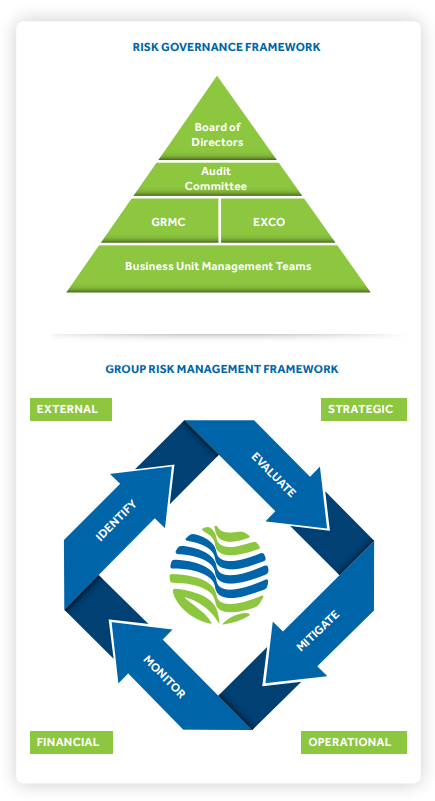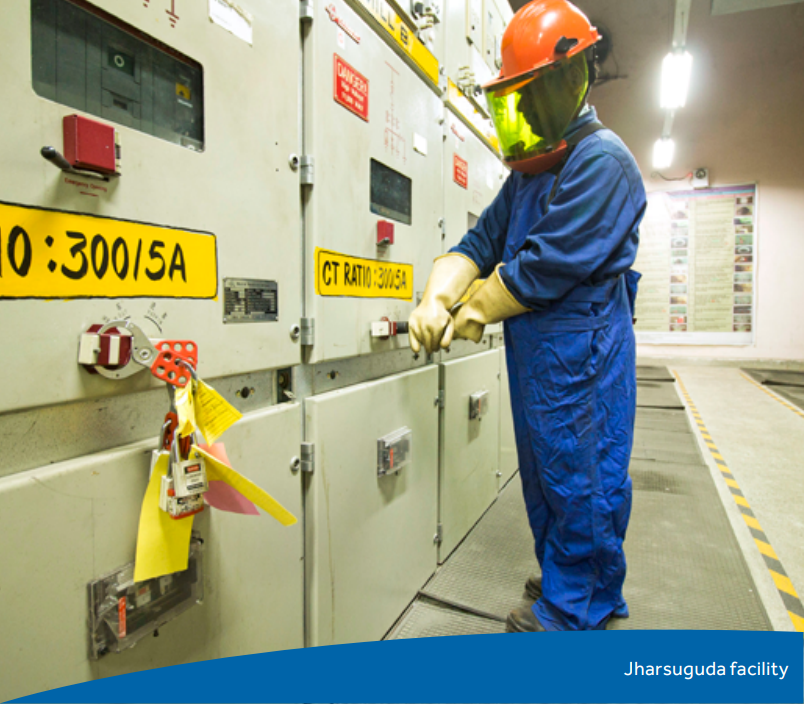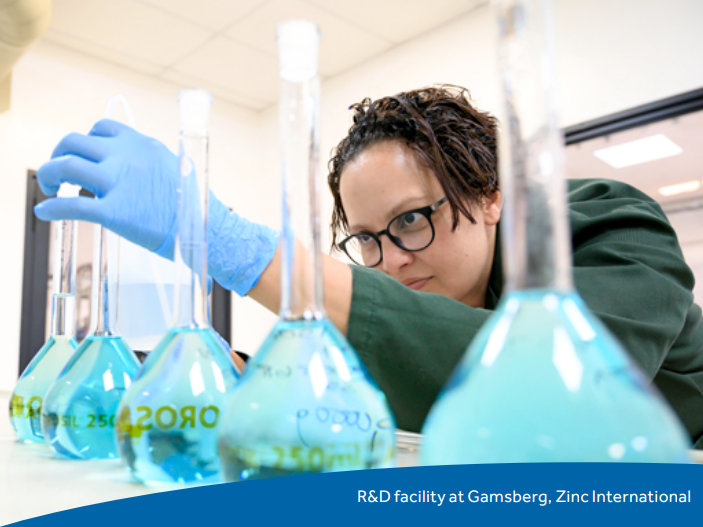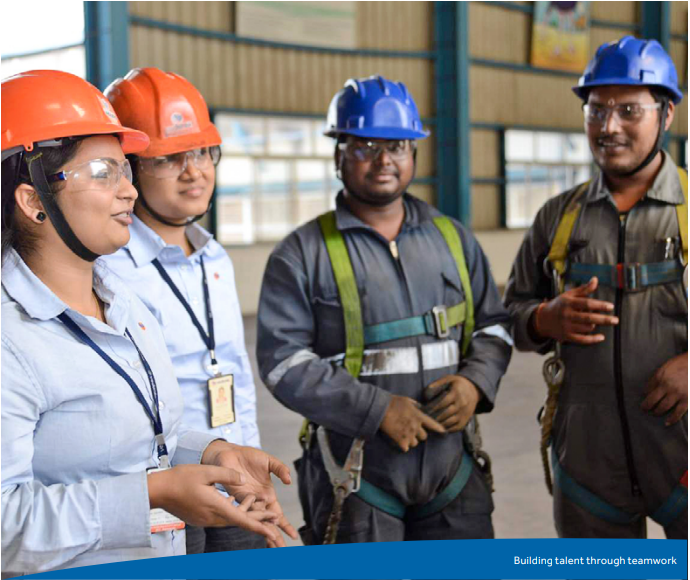
ENTERPRISE RISK MANAGEMENT
The Group has a multi-layered
risk-management framework that
aims to effectively manage the risks
that our businesses are exposed to
in the course of their operations,
as well as in their strategic actions.
We identify risks at the individual
business level for existing operations
as well as for ongoing projects
through a well-crafted methodology.
Formal discussion on risk
management takes place at business
level review meetings at least once
in a quarter. Every business division
of the Group has evolved its own risk
matrix, which gets reviewed by the
Business Management Committee.
In addition, business divisions have
developed their own risk registers.
Respective businesses review the
risks, changes in the nature and
extent of major risks since the last
assessment, control measures and
further action plans. The control
measures stated in the risk matrix
are also periodically reviewed by
the business management teams
to verify their effectiveness. These
meetings are chaired by the businessCEOs and attended by CXOs, senior
management and functional heads
concerned. The role of risk officers
at each business and at the Group
level is to create awareness on
risks at the senior management
level, and to develop and nurture a
risk-management culture within the
businesses. The Company’s
risk-mitigation plans are integral to
the KRAs / KPIs of process owners.
The governance of risk management
framework in the businesses is
anchored with the leadership teams.
The Audit & Risk Management
Committee aids the Board in the
risk management process through
identification and assessment
of any changes in risk exposure,
review of risk-control measures
and by approval of remedial
actions, wherever appropriate. The
Committee is, in turn, supported
by the Group Risk Management
Committee, which helps the Audit
& Risk Management Committee in
evaluating the design and operating
effectiveness of the risk-mitigation
programme and the control systems.
The Risk Management Committee
meets at least four times annually
to discuss risks and mitigation
measures. The Committee reviews
the robustness of our framework at
individual businesses and progress
against actions planned for key risks.

Our risk-management framework
is simple and consistent and
provide clarity on managing and
reporting risks to our Board.
Together, our management systems,
organisational structures, processes,
standards and code of conduct
and ethics represent the system of
internal control that governs how
the Group conducts its business and
manages the associated risks.
The Board shoulders the ultimate
responsibility for the management
of risks and for ensuring the
effectiveness of internal control
systems. It includes the Audit
Committee’s report on the risk
matrix, significant risks, and
mitigating actions that we have put
in place. Any systemic weaknesses
identified by the review areaddressed by enhanced procedures
to strengthen the relevant controls,
and these are reviewed regularly.
The Audit Committee is, in turn,
assisted by the Group-level
Risk Management Committee
in evaluating the design and
effectiveness of the risk-mitigation
programme and control systems.
The Group Risk Management
Committee (GRMC) meets every
quarter and comprises the Group
Chief Executive Officer, Group
Chief Financial Officer and DirectorManagement Assurance. The Group
Head-Health, Safety, Environment
& Sustainability is invited to attend
these meetings. GRMC discusses
key events impacting the risk profile,
relevant risks and uncertainties,
emerging risks and progress against
planned actions.
Since it is critical to the delivery of
the Group’s strategic objectives,
risk management is embedded in
business-critical activities, functions
and processes. The risk management
framework helps the Company by
aligning operating controls with the
Group’s objectives. It is designed to
manage rather than eliminate therisk of failure to achieve business
objectives and provides reasonable
and not absolute assurance against
material misstatement or loss.
Materiality and risk tolerance are
key considerations in our decisionmaking. The responsibility for
identifying and managing risks lies
with every manager and business
leader.
Additionally, other key risk governance and oversight committees in the Group comprise the following:
Additionally, there are various Group
level Management Committees
(ManComs) such as Procurement
ManCom, Sustainability - HSE
ManCom, CSR ManCom, and so on
which work on identifying risks in
those specific areas and mitigating
them.
Each business has developed its
own risk matrix, which is reviewed
by its respective management
committee/executive committee,
chaired by its CEO. In addition, each
business has developed its own
risk register depending on the size
of its operations and number of
SBUs/ locations. Risks across these
risk registers are aggregated and
evaluated and the Group’s principal
risks are identified, and a response
mechanism is formulated.
This element is an important
component of the overall internal
control process from which the
Board obtains assurance. The scope
of work, authority and resources
of the Management Assurance
Services (MAS) are regularly
reviewed by the Audit Committee.
The responsibilities of MAS include
recommending improvements
in the control environment and
reviewing compliance with our
philosophy, policies and procedures.
The planning of internal audits is
approached from a risk perspective.
In preparing the internal audit plan,
reference is made to the risk matrix,
and inputs are sought from senior
management, business teams and
members of the Audit Committee.
In addition, we refer to past audit
experience, financial analysis and the
prevailing economic and business
environment.

Despite COVID-induced disruptions Vedanta’s BUs dealt with its impact extremely well, resulting in an effective response. This was made possible owing to the following:
As a result, our facilities remained
largely operational during the
pandemic, despite challenges.
Rather, the disruption created an
opportunity for us to identify and
work on certain transformational
aspects for the future. We continue
to remain committed to achieving our
objectives of zero harm, zero wastage
and zero discharge, thus creating
sustainable stakeholder value.
The order in which the risks appear in
the next section does not necessarily
reflect the likelihood of their
occurrence or the relative magnitude
of their impact on Vedanta’s
businesses. The risk direction of
each risk has been reviewed based
on events, economic conditions,
changes in business environment and
regulatory changes during the year.
While Vedanta’s risk management
framework is designed to help the
organisation meet its objectives,
there is no guarantee that the
Group’s risk-management activities
will mitigate or prevent these or
other risks from occurring.
The Board, with the assistance of the management, conducts periodic and robust assessments of principal risks and
uncertainties of the Group, and tests the financial plans for each risk and uncertainty mentioned below.
SUSTAINABILITY RISKS
Health, safety and environment (HSE)
| Impact | Mitigation | Direction |
|---|---|---|
|
The resources sector is subject
to extensive health, safety and
environmental laws, regulations
and standards. Evolving
requirements and stakeholder
expectations could result in
increased cost or litigation or
threaten the viability of operations
in extreme cases.
Emissions and climate change: Our global presence exposes us to a number of jurisdictions in which regulations or laws have been, or are being, considered to limit or reduce emissions. The likely effect of these changes could be increase in the cost for fossil fuels, levies for emissions in excess of certain permitted levels, and increase in administrative costs for monitoring and reporting. Increasing regulation of greenhouse gas (GHG) emissions, including the progressive introduction of carbon emissions trading mechanisms and tighter emission reduction targets, is likely to raise costs and reduce demand growth. |
|
|

Managing relationship with stakeholders
| Impact | Mitigation | Direction |
|---|---|---|
| The continued success of our existing operations and future projects are in part dependent on the broad support and a healthy relationship with our respective local communities. Failure to identify and manage local concerns and expectations can have a negative impact on relations and therefore affect the organisation’s reputation and social licence to operate and grow. |
|
|
Tailings dam stability
| Impact | Mitigation | Direction |
|---|---|---|
| This signifies release of waste material leading to loss of life, injuries, environmental damage, reputational damage, financial costs and production impacts. A tailings dam failure is considered to be a catastrophic risk – i.e. a very high severity but very low frequency event that must be given the highest priority |
|
|
OPERATIONAL RISKS
Challenges in Aluminium and Power business
| Impact | Mitigation | Direction |
|---|---|---|
| Our projects have been completed and may be subject to a number of challenges during operationalisation phase. These may also include challenges around sourcing raw materials and infrastructure-related aspects and concerns around Ash utilisation / evacuation |
|
|
Discovery risk
| Impact | Mitigation | Direction |
|---|---|---|
| Increased production rates from our growth-oriented operations place demand on exploration and prospecting initiatives to replace reserves and resources at a pace faster than depletion. A failure in our ability to discover new reserves, enhance existing reserves or develop new operations in sufficient quantities to maintain or grow the current level of our reserves could negatively affect our prospects. There are numerous uncertainties inherent in estimating ore and Oil & Gas reserves, and geological, technical, and economic assumptions that are valid at the time of estimation. These may change significantly when new information becomes available. |
|
|
Breaches in IT / cybersecurity
| Impact | Mitigation | Direction |
|---|---|---|
| Like many global organisations, our reliance on computers and network technology is increasing. These systems could be subject to security breaches resulting in theft, disclosure, or corruption of key/strategic information. Security breaches could also result in misappropriation of funds or disruptions to our business operations. A cybersecurity breach could have an impact on business operations. |
|
|
Loss of assets or profit due to natural calamities
| Impact | Mitigation | Direction |
|---|---|---|
| Our operations may be subject to a number of circumstances not wholly within the Group’s control. These include damage to or breakdown of equipment or infrastructure, unexpected geological variations or technical issues, extreme weather conditions and natural disasters – any of which could adversely affect production and/or costs. |
|
|
Cairn related challenges
| Impact | Mitigation | Direction |
|---|---|---|
| Cairn India has 70% participating interest in Rajasthan Block. The production sharing contract (PSC) of Rajasthan Block runs till 2020. The Government of India has granted its approval for ten-year extension at less favourable terms, pursuant to its policy for extension of Pre-NELP Exploration Blocks, subject to certain conditions. Ramp up of production vs envisaged may have impact on profitability. |
|
|
COMPLIANCE RISKS
Regulatory and legal risk
| Impact | Mitigation | Direction |
|---|---|---|
| We have operations in many countries around the globe. These may be impacted because of legal and regulatory changes in the countries in which we operate resulting in higher operating costs, and restrictions such as the imposition or increase in royalties or taxation rates, export duty, impacts on mining rights/bans, and change in legislation. |
|
|
Tax related matters
| Impact | Mitigation | Direction |
|---|---|---|
| Our businesses are in a tax regime and changes in any tax structure or any tax-related litigation may impact our profitability. |
|
|
FINANCIAL RISKS
Fluctuation in commodity prices (including oil) and currency exchange rates
| Impact | Mitigation | Direction |
|---|---|---|
|
Prices and demand for the Group’s
products may remain volatile/
uncertain and could be influenced
by global economic conditions,
natural disasters, weather,
pandemics, such as the COVID-19
outbreak, political instability, and
so on. Volatility in commodity
prices and demand may adversely
affect our earnings, cash flow and
reserves.
Our assets, earnings and cash flows are influenced by a variety of currencies due to our multi-geographic operations. Fluctuations in exchange rates of those currencies may have an impact on our financials. |
|
|
Major project delivery
| Impact | Mitigation | Direction |
|---|---|---|
| Shortfall in achievement of expansion projects’ stated objectives leading to challenges in achieving stated business milestones – existing and new growth projects. |
|
|
Access to capital
| Impact | Mitigation | Direction |
|---|---|---|
| The Group may not be able to meet its payment obligations when due or may be unable to borrow funds in the market at an acceptable price to fund actual or proposed commitments. A sustained adverse economic downturn and/or suspension of its operation in any business, affecting revenue and free cash flow generation, may cause stress on the Company’s ability to raise financing at competitive terms. |
|
|
